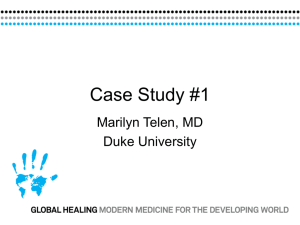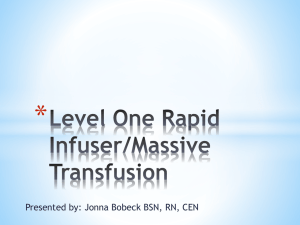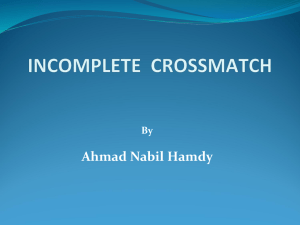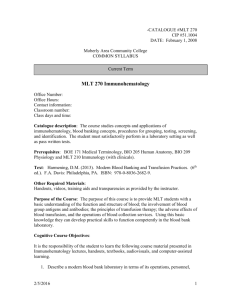Invited Review
advertisement
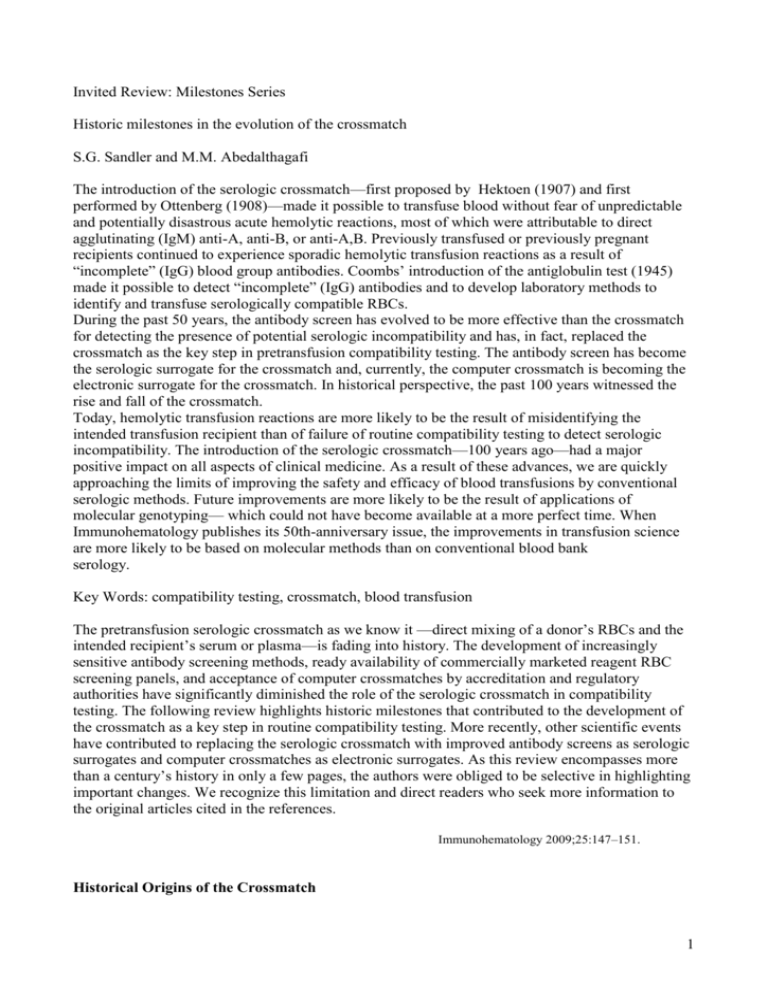
Invited Review: Milestones Series Historic milestones in the evolution of the crossmatch S.G. Sandler and M.M. Abedalthagafi The introduction of the serologic crossmatch—first proposed by Hektoen (1907) and first performed by Ottenberg (1908)—made it possible to transfuse blood without fear of unpredictable and potentially disastrous acute hemolytic reactions, most of which were attributable to direct agglutinating (IgM) anti-A, anti-B, or anti-A,B. Previously transfused or previously pregnant recipients continued to experience sporadic hemolytic transfusion reactions as a result of “incomplete” (IgG) blood group antibodies. Coombs’ introduction of the antiglobulin test (1945) made it possible to detect “incomplete” (IgG) antibodies and to develop laboratory methods to identify and transfuse serologically compatible RBCs. During the past 50 years, the antibody screen has evolved to be more effective than the crossmatch for detecting the presence of potential serologic incompatibility and has, in fact, replaced the crossmatch as the key step in pretransfusion compatibility testing. The antibody screen has become the serologic surrogate for the crossmatch and, currently, the computer crossmatch is becoming the electronic surrogate for the crossmatch. In historical perspective, the past 100 years witnessed the rise and fall of the crossmatch. Today, hemolytic transfusion reactions are more likely to be the result of misidentifying the intended transfusion recipient than of failure of routine compatibility testing to detect serologic incompatibility. The introduction of the serologic crossmatch—100 years ago—had a major positive impact on all aspects of clinical medicine. As a result of these advances, we are quickly approaching the limits of improving the safety and efficacy of blood transfusions by conventional serologic methods. Future improvements are more likely to be the result of applications of molecular genotyping— which could not have become available at a more perfect time. When Immunohematology publishes its 50th-anniversary issue, the improvements in transfusion science are more likely to be based on molecular methods than on conventional blood bank serology. Key Words: compatibility testing, crossmatch, blood transfusion The pretransfusion serologic crossmatch as we know it —direct mixing of a donor’s RBCs and the intended recipient’s serum or plasma—is fading into history. The development of increasingly sensitive antibody screening methods, ready availability of commercially marketed reagent RBC screening panels, and acceptance of computer crossmatches by accreditation and regulatory authorities have significantly diminished the role of the serologic crossmatch in compatibility testing. The following review highlights historic milestones that contributed to the development of the crossmatch as a key step in routine compatibility testing. More recently, other scientific events have contributed to replacing the serologic crossmatch with improved antibody screens as serologic surrogates and computer crossmatches as electronic surrogates. As this review encompasses more than a century’s history in only a few pages, the authors were obliged to be selective in highlighting important changes. We recognize this limitation and direct readers who seek more information to the original articles cited in the references. Immunohematology 2009;25:147–151. Historical Origins of the Crossmatch 1 In 1907, Ludwig Hektoen, a pathologist at Chicago’s Institute for Infectious Diseases, suggested, for the first time on record, that direct matching of donors’ and recipients’ blood could prevent the potential adverse effects that had been observed after many blood transfusions.1,2 Commenting on Landsteiner’s observation that the serum of some persons agglutinated the RBCs of certain others, Hektoen speculated that “under special conditions, homologous transfusion might prove dangerous by leading to agglutination within the vessels of the subject transfused.”1 Although Hektoen did not perform actual serologic crossmatches, historians credit him as being the first physician to propose direct pretransfusion donor-recipient crossmatching.3–5 Before Hektoen’s suggestion, transfusions of animal or human blood had been conducted without pretransfusion serologic testing and, as might be anticipated, some transfusions appeared to be beneficial, but others were disastrous.6 Only a few years before Hektoen’s proposal, Landsteiner had succeeded in differentiating human RBCs into three serologic groups (A, B, O),7 but neither Landsteiner nor other contemporary laboratory investigators linked the serologic differences between human RBCs to the cause of sporadic hemolytic transfusion reactions. In 1908, Ottenberg performed the first serologic crossmatch on record, mixing the blood of a wife (donor) and her husband (recipient) and observing the absence of hemolysis before an uneventful 17-minute direct donor-recipient transfusion.8 Ottenberg did not provide details of how he performed the first pretransfusion donor-patient crossmatch, but he proposed “that a thing much to be desired is, that a convenient clinical test for this purpose be devised.”8 Physicians were slow to recognize the potential importance of pretransfusion serologic testing for preventing hemolytic transfusion reactions. Among the skeptics was George Crile, a surgeon in Cleveland, who had pioneered direct patient-to-recipient transfusions.9 Crile wrote “contrary to common belief, normal blood of one individual does quite as well as that of another. Kinship apparently is of no special advantage.”10 IMMUNOHEMATOLOGY, Volume 25, Number 4, 2009 S.G. Sandler and M.M. Abedalthagafi The Indirect Antiglobulin Test and Its Modifications Ottenberg’s approach of pretransfusion serologic matching of donor’s RBCs and recipient’s serum was slowly accepted by surgeons and obstetricians, who performed most transfusions at that time. During the next four decades, pretransfusion serologic crossmatching was gradually introduced in hospitals in the United States. By eliminating those donor-recipient incompatibilities that were detectable by direct hemagglutination, i.e., ABO incompatibilities, the room-temperature direct crossmatch eliminated most acute and disastrous hemolytic reactions. Nevertheless, sporadically, a previously transfused or previously pregnant transfusion recipient experienced an acute or delayed hemolytic transfusion reaction. In 1945, Coombs et, al. published their observation that rabbit antihuman serum could identify “incomplete” antibodies, and the antihuman globulin (AHG) phase of donor RBC–recipient serum matching was added to procedures for antibody screening and crossmatching.11 The addition of an AHG phase to compatibility testing was a major advance; and the AHG phase remains the most effective of all laboratory methods for ensuring serologic compatibility of ABO-matched RBC transfusions. Soon, other investigators proposed modifications of the antibody screen to increase its sensitivity for detecting blood group antibodies. Among the more notable modifications were the addition of albumin,12,13 trypsin,14,15 papain,16 dextran,17 ficin,18 bromelin,19 low-ionic-strength solution (LISS),20 polyethylene glycol (PEG),21 and hexadimethrine bromide.22 Editors of the first edition of the American Association of Blood Banks’ (AABB) Standards for a Blood Transfusion Service (1958) required a major crossmatch, but the minor crossmatch was optional.23 For the major crossmatch, “at least two methods shall be used, one to demonstrate optimally the presence of serum or saline active antibodies, and another to detect the presence of incomplete (blocking) antibodies.”23 The acceptable methods were as follows:23 2 1. A saline or serum crossmatch with 2% donor RBCs, read at room temperature and after an indirect antiglobulin test. 2. A saline or serum crossmatch in addition to a high protein (bovine albumin) slide test, read on a heated slide resting on a view box. 3. Both a saline or serum crossmatch and a tube technic (recipient’s serum, albumin, and donor’s RBCs incubated for 10 to 20 minutes, centrifuged, and read). The third edition of Standards (1962) recognized “enzyme systems” as an option for antibody screening for the first time and introduced the requirement that the “antiglobulin system [for crossmatching] shall utilize antihuman serum meeting N.I.H. standards….”24 The Antibody Screen as a Surrogate for the Serologic Crossmatch Commercially marketed panels of reagent RBCs for screening for blood group antibodies began to appear in the United States in the late 1950s and early 1960s. In 1962, for the first time, Standards (3rd edition) recognized a limited role for reagent RBCs for the detection of antibodies in patients’ sera.24 The Standards’ acceptance of reagent RBCs as a surrogate for the direct crossmatching of donor RBCs and patients’ sera was not without controversy. Grove-Rasmussen communicated his concern in Transfusion, commenting that stored reagent RBCs may not be “in as good condition” as freshly donated RBCs and may not express all pertinent antigens.25 Alternatives to Testing for Hemagglutination in Test Tubes From the outset, antibody screens and crossmatches in US hospitals were performed mostly in test tubes and, less frequently, by rapid slide method. Alternative formats have been introduced, primarily to decrease the volume of reagents. These methods include capillary tubes,26 microtiter plates,27 solid-phase plates,28 and gel agglutination.29 However, only the microplate method has been used extensively as an alternative for crossmatching.30, 31 The Rise of the Antibody Screen and the Fall of the Serologic Crossmatch As methods to improve the sensitivity of the antibody screen improved, the importance of a direct serologic crossmatch of donor’s RBCs and recipient’s plasma became less critical. In fact, from the first proposal of the pretransfusion crossmatch until the present, direct serologic matching of donor’s RBCs and patient’s serum or plasma has been recognized as a highly desirable, but not absolutely required, step in issuing RBCs for transfusion. Among the clinical situations in which the crossmatch is often omitted are life-threatening hemorrhages, 32 after massive transfusions when most of the recipient’s blood has been replaced by donor’s blood,32 and for infants younger than 4 months of age.33 In 1980, Winn and colleagues proposed that an extended antibody screen could replace the crossmatch if the results of ABO typing and antibody screen were verified and documented.34 In 2000, Kuriyan and Fox reported their experience transfusing RBCs without a serologic crossmatch if the antibody screen was negative and if the ABO was confirmed by two technologists.35 In their hospital, eliminating the crossmatch decreased the cost of compatibility testing 40 percent ($32,968); retaining the immediate spin crossmatch saved 30 percent ($24,748). In a larger hospital, eliminating the AHG crossmatch after a negative antibody screen saved $70,000 per year.36 In 1985, Shulman and colleagues reported the effect of switching from a conventional crossmatch (readings after immediate spin, 37°C incubation, and AHG phase) to an abbreviated crossmatch immediate spin only) for patients without blood group alloantibodies. 36 IMMUNOHEMATOLOGY, Volume 25, Number 4, 2009 3 During an 8.5-month experience, they performed 27,742 crossmatches and avoided 46,959 unnecessary crossmatches, decreasing costs by at least $49,300 annually. In 1992, Judd and colleagues published a study entitled “Can the reading for serological reactivity following 37°C incubation be eliminated?”37 Before conducting the study, they had the impression that the 37°C reading contributed minimally to transfusion safety. However, after their review identified approximately 25 patients with 37°C-only antibodies with Rh, Kell, or Kidd specificity annually, they decided to retain the 37°C reading. Seven years later, Judd and colleagues revisited the issue.38 Using data from prior publications, they estimated the risk that eliminating different components of the compatibility test would introduce in their hospital. The result was that the risk for transfusing incompatible blood by eliminating the direct AHG test, the indirect AHG crossmatch, and 37°C reading would be approximately 1:13,000, 1:2,000, and 1:2,400 units transfused.38 Given this history of scientific and technical events, what is the current state of the art? Not all proposed variations of the serologic crossmatch have survived the test of time. In 2008, the College of American Pathologists distributed a proficiency survey that consisted of a donor RBC sample (J-13R) to be crossmatched with a patient’s serum sample (J-10S) containing an unknown antibody (anti-Jka).39 Of 2,572 laboratories reporting results for antibody screening, 874 (34.0%) used a tube method; 94 (3.7%), solid-phase red cell adherence (SPRCA); and 1604 (62.3%), gel agglutination. For those using a tube method, 27 (3.0%) used saline AHG; 54 (6.2%), albumin AHG; 561 (64.1%) used LISS AHG; and 234 (26.7%) used PEG AHG. Having identified (or misidentified) the anti-Jka, 1821 laboratories reported performing an AHG crossmatch. Of these, 107 (5.9%) used saline AHG; 137 (7.6 %), albumin AHG; 1201(65.9%), LISS AHG; and 376 (20.6%) PEG AHG).39. Notably, the number of hospitals using enzymetreated reagent RBCs for routine antibody screening was too few to be listed as a separate category. Automated Crossmatching The first widely used automated serologic analyzer performed ABO grouping and Rh(D) typing, but not crossmatching.40 The first automated analyzer that did incorporate the option for a serologic donor RBC–recipient plasma crossmatch was the ABS2000 (Immucor, Norcross, GA).30, 31 Most hospitals that acquired an ABS2000, including our hospital, did not take advantage of the crossmatch option, preferring a manual immediate-spin crossmatch for patients with negative AHG antibody screens as a more practical alternative. Eliminating the Crossmatch: the Computer Crossmatch Evolution of the crossmatch In 1991, Judd published an editorial asking the question, “Are there better ways than the crossmatch to demonstrate ABO incompatibility?”41 Shortly thereafter, Butch, Judd, and colleagues at Blood Bank at the University of Michigan Hospital initiated a procedure to confirm donor recipient compatibility by electronic verification, i.e., by a computer crossmatch.42 In 1994, these investigators reported their experience using a computer crossmatch for pretransfusion tests for 14,021 patients between February 1992 and March 1993. Their report included a detailed standard operating procedure, consisting of specific requirements for (1) RBC unit processing, (2) patient sample processing, (3) crossmatch for ABO compatibility, and (4) release of RBC units for transfusion. As suggested by Judd’s 1991 editorial, the key remaining function of the serologic crossmatch was ensuring ABO compatibility for RBC transfusions. The function of detecting antibodies in the recipient’s serum against antigens on donors’ RBCs had been co-opted by the antibody screen. Although AABB Standards allowed computer crossmatching to replace the immediate-spin crossmatch by the 15th edition (1993),43 the logistics of writing software for individual hospital information systems limited widespread implementation.42 In 1998, Judd reported to attendees of the International Society of Blood Transfusion’s congress in 4 Hong Kong that there were electronic crossmatching procedures in use in at least 10 North American facilities, Scandinavia, Hong Kong, and Australia.44 Progress in widespread implementation of the computer crossmatch has been slow, but the historic milestone has been established as many blood banks have moved forward. Impact of Serologic Methods on Clinical Practice We now change gears, moving from an objective history of the serologic crossmatch to more subjective opinions about how these historic milestones have impacted the practice of medicine. Surely, the starting point is Hektoen’s suggestion that Landsteiner’s newly described serologic blood groups may be related etiologically to observations of unpredictable acute hemolytic reactions after certain blood transfusions. When Ottenberg moved Hektoen’s suggestion forward and performed the first serologic crossmatch, he initiated the era of safe blood transfusion. It was now possible to perform surgery and treat hemorrhage without the fear of an unpredicted, acute, and potentially fatal hemolytic reaction. Coombs’ development of antihuman globulin provided the next major impact, significantly decreasing the risk of hemolytic reactions attributable to non-ABO IgG blood group antibodies. By 1945, transfusions of RBCs could be administered without fear of an ABO related acute hemolytic reaction, and severe reactions from non-ABO antibodies were relatively uncommon. With the risk of acute and delayed hemolytic reactions greatly decreased, surgeons were not only able to manage trauma, obstetrical hemorrhage, and gastrointestinal bleeding, but also to develop procedures for previously impossible cardiovascular and cancer surgeries requiring large numbers of blood transfusions. Subsequent refinements in methods for antibody screening and identification, although a major focus in the blood banking community, have had only an incremental impact on the practice of medicine. Even the introduction of the computer crossmatch—clearly a major advance for efficient management of pretransfusion laboratory testing—has only a minor impact, if any, on clinical practice. After 100 years of some broad strides and many incremental improvements, the serologic crossmatch has evolved to a standardized, highly sensitive, and safe laboratory practice. The heyday of discovering new blood group antigens and developing incrementally more sensitive serologic methods may be passing, but there are new and challenging opportunities for transfusion science and blood banking. The availability of molecular genotyping to further define blood group antigens has opened new vistas for blood group science.45 Molecular science offers the promise of improved efficacy of transfusions of RBCs, particularly for those chronically transfused patients for whom conventional compatibility testing does not ensure satisfactory outcomes. As we look back and honor the contributions of our colleagues in this 25th anniversary issue of Immunohematology, we can only speculate on what further advances will be published in future issues of Immunohematology and featured in the next historical review. IMMUNOHEMATOLOGY, Volume 25, Number 4, 2009 S.G. Sandler and M.M. Abedalthagafi References 1. Hektoen L. Isoagglutination of human corpuscles with respect to demonstration of opsonic index and to transfusion of blood. JAMA 1907;48:1739–40. 2. Hektoen L. Isoagglutination of human corpuscles. J Infect Dis 1907;4:297–303. 3. Rosenfield RE. Early twentieth century origins of modern blood transfusion therapy. Mt Sinai J Med 1974;41:626–35. 4. Lederer SE. Flesh and blood: organ transplantation and blood transfusion in twentieth-century America. New York: Oxford University Press, 2008. 5 5. Diamond LK. The story of our blood groups. In: Wintrobe MM, ed. Blood pure and eloquent: a story of discovery, of people, and of ideas. New York: McGraw-Hill Book Company, 1980:691717. 6. Oberman H. The history of transfusion medicine. In: Petz LA, Swisher SN, eds. Clinical practice of transfusion medicine. 2nd ed. New York: Churchill Livingstone, 1989:9–30. 7. Garratty G, Dzik W, Issitt PD, et al. Terminology for blood group antigens and genes—historical origins and guidelines in the new millennium. Transfusion 2000;40:477–89. 8. Ottenberg R. Transfusion and arterial anastomosis: some experiments in arterial anastomosis and a study of transfusion with presentation of two clinical cases. Ann Surg 1908;47:486–505. 9. Crile GW. The technique of direct transfusion of blood. Ann Surg 1907;46:329–32. 10. Crile GW. Further observations on transfusion with a note on hemolysis. Surg Gynecol Obstet 1909;9:16–8. 11. Coombs RR, Mourant AE, and Race RR. A new test for the detection of weak and “incomplete” Rh agglutinins. Br Exp Pathol 1945;26: 255-66. 12. Dodge OG. A comparative study of direct matching techniques in blood transfusion. J Clin Pathol 1952;5:102– 7. 13. Stroup M, MacIlroy M. Evaluation of the albumin antiglobulin technic in antibody detection. Transfusion 1965;5:184–91. 14. Morton JA, Pickles MM. The proteolytic enzyme test for detecting incomplete antibodies. J Clin Pathol 1951;4:189–99. 15. Rosenfield RE, Vogel P. The identification of hemagglutinins with red cells altered with trypsin. Trans N Y Acad Sci 1951;13:213–20. 16. Goldsmith K. Papain-treated red cells in the detection of incomplete antibodies. Lancet 1955;268:76–7. 17. Munk-Andersen G. A dextran serum medium for the demonstration of incomplete anti-A and anti-B; a direct conglutination test for the demonstration of in-vivo sensitization with incomplete ABO antibody of the red cells of newborn infants. Acta Pathol Microbiol Scand 1956;38:259-72. 18. Haber G, Rosenfield R. Ficin treated red cells for hemagglutination studies. P.H. Andresen, Papers in dedication of his 60th birthday, Munksgaard, Copenhagen, 1957:45–9. 19. Pirofsky B, Mangum ME Jr. Use of bromelin to demonstrate erythrocyte antibodies. Proc Soc Exp Biol Med 1959;101:49–52. 20. Hughes-Jones NC, Polley MJ, Telford R, et al. Optimal conditions for detecting blood group antibodies by the antiglobulin test. Vox Sang 1964;9:385–95. 21. Nance SJ, Garratty G. A new potentiator of red blood cell antigen-antibody reactions. Am J Clin Pathol 1987;87:633–5. 22. Lalezari P. The manual hexadimethrine bromide (polybrene) test: effects of serum proteins and practical applications. Transfusion 1987;27:295–301. 23. Strumia MM, Jenkins ER, eds. Standards for a blood transfusion service. 1st ed. Washington, DC: American Association of Blood Banks, 1958:17. 24. Strumia MM, Lesses MF, eds. Standards for a blood transfusion service. 3rd ed. Washington, DC: American Association of Blood Banks, 1962:13. 25. Grove-Rasmussen M. Routine compatibility testing: standards of the AABB as applied to compatibility tests. Transfusion 1964;4:200–5. 26. Chown B. A rapid, simple and economical method for Rh agglutination. Am J Clin Pathol 1944;14:144-50. IMMUNOHEMATOLOGY, Volume 25, Number 4, 2009 6 27. Crawford MN, Gottman FE, Gottman CA. Microplate system for routine use in blood bank laboratories. Transfusion 1970;10:258–63. 28. Beck ML, Rachel JM, Sinor LT, Plapp FV. Semi automated solid phase assays for pretransfusion testing. Med Lab Sci 1984;41:374–81. 29. Lapierre Y, Rigal D, Adam J, et al. The gel test: a new way to detect red cell antigen-antibody reactions. Transfusion 1990;30:109–13. 30. Sandler SG, Langeberg A, Avery N, Mintz PD. A fully automated blood typing system for hospital transfusion services. Transfusion 2000;40:201–7. 31. Sandler SG, Langeberg A, Rumsey AH, Novak SC. A solid phase and microtiter hemagglutination method for pretransfusion compatibility testing. Haematologia (Budapest) 2000;30:149–57. 32. Oberman HA, Barnes BA, Friedman BA. The risk of abbreviating the major crossmatch in urgent or massive transfusion. Transfusion 1978;18:137–41. 33. DePalma L. Review: red cell alloantibody formation in the neonate and infant: considerations for current immunohematologic practice. Immunohematology 1992;8:33–7. 34. WinnLC,SvodaR,HafleightEB,GrumentFC.Anextended antibody screen to replace the crossmatch. Presented at the 33rd Annual Meeting of the American Association of Blood Banks, Washington, DC, 1980. 35. Kuriyan M, Fox E. Pretransfusion testing without serologic crossmatch: approaches to ensure patient safety. Vox Sang 2000;78:113–8. 36. Shulman IA, Nelson JM, Kent DR, et al. Experience with a cost-effective crossmatch protocol. JAMA 1985;254:93–5. 37. Judd WJ, Steiner EA, Oberman HA, Nance SJ. Can the reading for serologic reactivity following 37 degrees C incubation be omitted? Transfusion 1992;32:304–8. Evolution of the crossmatch 38. Judd WJ, Fullen DR, Steiner EA, et al. Revisiting the issue: can the reading for serologic reactivity following 37 degrees C incubation be omitted? Transfusion 1999;39:295–9. 39. Transfusion Medicine Resource Committee. Surveys 2008 and Anatomic Pathology Education Programs. J-B Transfusion Medicine (Comprehensive) and Educational Challenge. Northfield, IL: College of American Pathologists, 2008. 40. McNeil C, Helmick WM, Ferrari A. A preliminary investigation into automatic blood grouping. Vox Sang 1963;8:235–41. 41. Judd WJ. Are there better ways than the crossmatch to demonstrate ABO incompatibility? Transfusion 1991;31:192–4. 42. Butch SH, Judd WJ, Steiner EA, et al. Electronic verification of donor-recipient compatibility: the computer crossmatch. Transfusion 1994;34:105–9. 43. Widmann, FK, ed. Technical manual. 15th ed. Bethesda, MD: AABB, 1993:25. 44. Judd WJ. Requirements for the electronic crossmatch. Vox Sang 1998;74(Suppl 2):409–17. 45. Westhoff CM, Sloan SR. Molecular genotyping in transfusion medicine. Clin Chem 2008;54:1948–50. S. Gerald Sandler, MD (corresponding author), Professor of Medicine and Pathology, Director, Transfusion Medicine, Department of Laboratory Medicine, Room M-1306, Georgetown University Hospital, Washington, DC 20007, and Malak M. Abedalthagafi, MD, Chief Resident, Department of Pathology, Georgetown University Medical Center, Washington, DC. IMMUNOHEMATOLOGY, Volume 25, Number 4, 2009 7
